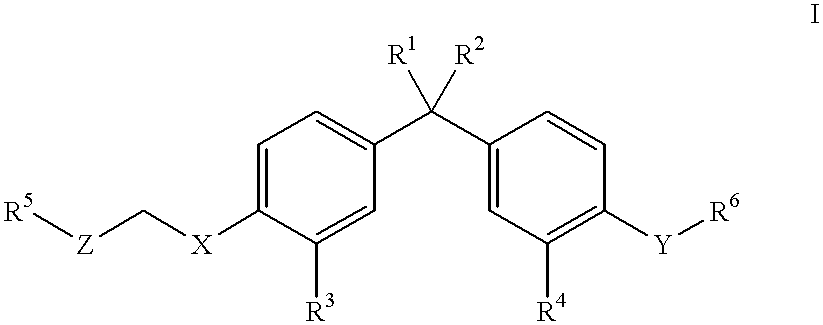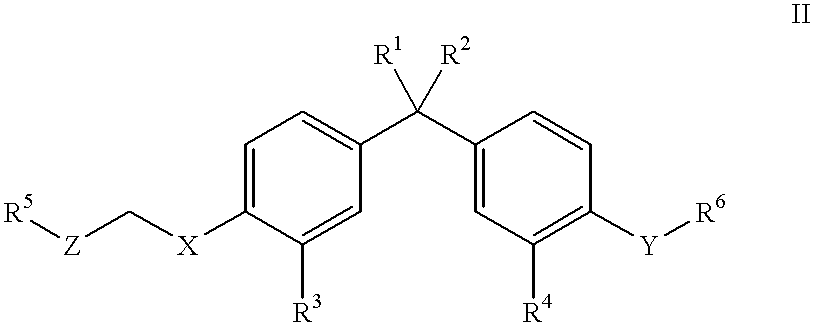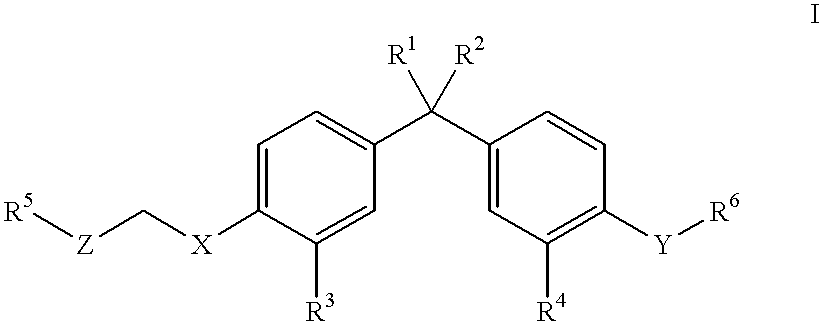Vitamin D3 mimics
a technology of vitamin d3 and mimics, applied in the field of vitamin d3 mimics, can solve the problems of limited usefulness, hypercalcemia (elevated serum calcium), soft tissue calcification,
- Summary
- Abstract
- Description
- Claims
- Application Information
AI Technical Summary
Problems solved by technology
Method used
Image
Examples
example 1
Preparation of 1,1-bis[4-hydroxy-3-methylphenyl]cyclohexane (3). ##STR11##
To a solution of o-cresol (5 g, 46.3 mmol) and cyclohexanone (2 g, 20.4 mmol) in acetic acid (20 mL) was added conc H.sub.2 SO.sub.4 (4 mL). The reaction mixture was stirred at ambient temperature for 3 days, poured over ice, and diluted with 1:5 ethyl acetate / hexanes. The organic fraction was separated, washed with water and brine, dried over MgSO.sub.4, and concentrated in vacuo. Chromatography (silica, 5% ethyl acetate in hexanes) afforded 1.8 g of diphenol 3. .sup.1 HNMR (CDCl.sub.3) .delta.: 6.98 (d, J=2 Hz, 2 H, Ar--H), 6.95 (dd, J=2 Hz, J=8.6 Hz, 2 H, Ar--H), 6.64 (d, J=8.6 Hz, 2 H, Ar--H), 2.19 (s, 6 H, Ar--CH.sub.3), 2.19 (m, 4 H, CH.sub.2), 1.27-1.52 (m, 6 H, CH.sub.2).
example 2
Preparation of 1,1-bis[3-methyl-4-(3,3-dimethyl-2-oxobutoxy)phenyl]cyclohexane (4). ##STR12##
To a solution of the compound of Example 1 (1.0 g, 3.37 mmol) in DMF (10 mL) was added NaH (306 mg, 8.00 mmol). The reaction mixture was stirred 5 min and chloropinacolone (1.07 g, 8.00 mmol) was added. The reaction mixture was stirred 30 min, then quenched with water and diluted with ethyl acetate. The organic fraction was separated, washed with water and brine, dried over MgSO.sub.4, and concentrated in vacuo. Chromatography (silica, 10% ethyl acetate in hexanes) afforded 820 mg (1.66 mmol) of 4. .sup.1 HNMR (CDCl.sub.3) .delta.: 7.09 (d, J=2 Hz, 2 H, Ar--H), 6.96 (dd, J=2 Hz, J=8.6 Hz, 2 H, Ar--H), 6.51 (d, J=8.6 Hz, 2 H, Ar--H), 4.82 (s, 4 H, CH.sub.2 O), 2.25 (s, 6 H, Ar--CH.sub.3), 2.19 (m, 4 H, CH.sub.2), 1.27-1.52 (m, 6 H, CH.sub.2), 1.25 (s, 18 H, t-Bu).
example 3
Preparation of 3,3-bis[4-hydroxy-3-methyl]pentane (6). ##STR13##
To a solution of o-cresol (5 g, 46.3 mmol) and 3-pentanone (2 g, 23.2 mmol) in acetic acid (20 mL) was added conc H.sub.2 SO.sub.4 (4 mL). The reaction mixture was stirred at ambient temperature for 3 days, poured over ice, and diluted with 1:5 ethyl acetate / hexanes. The organic fraction was separated, washed with water and brine, dried over MgSO.sub.4, and concentrated in vacuo. Chromatography (silica, 5% ethyl acetate in hexanes) afforded 2.2 g of diphenol 6. .sup.1 HNMR (CDCl.sub.3) .delta.: 6.90 (d, J=2 Hz, 2 H, Ar--H), 6.95 (dd, J=2 Hz, J=8.6 Hz, 2 H, Ar--H), 6.64 (d, J=8.6 Hz, 2 H, Ar--H), 2.21 (s, 6 H, Ar--CH.sub.3), 2.0 (q, J=7.3 Hz, 4 H, CH.sub.2 CH.sub.3), 0.60 (t, J=7.3 Hz, 4 H, CH.sub.2 CH.sub.3).
PUM
| Property | Measurement | Unit |
|---|---|---|
| Fraction | aaaaa | aaaaa |
| Time | aaaaa | aaaaa |
| Time | aaaaa | aaaaa |
Abstract
Description
Claims
Application Information
 Login to View More
Login to View More - R&D
- Intellectual Property
- Life Sciences
- Materials
- Tech Scout
- Unparalleled Data Quality
- Higher Quality Content
- 60% Fewer Hallucinations
Browse by: Latest US Patents, China's latest patents, Technical Efficacy Thesaurus, Application Domain, Technology Topic, Popular Technical Reports.
© 2025 PatSnap. All rights reserved.Legal|Privacy policy|Modern Slavery Act Transparency Statement|Sitemap|About US| Contact US: help@patsnap.com



